Experience the irresistible allure of Pork Bone Soup (Gamjatang), a Korean classic stew brimming with rich pork neck bones, tender potatoes, fragrant ginger, and savory soybean chili paste. Dive into a world of authentic Korean flavors with this hearty and comforting recipe perfect for warming up on a cold day.
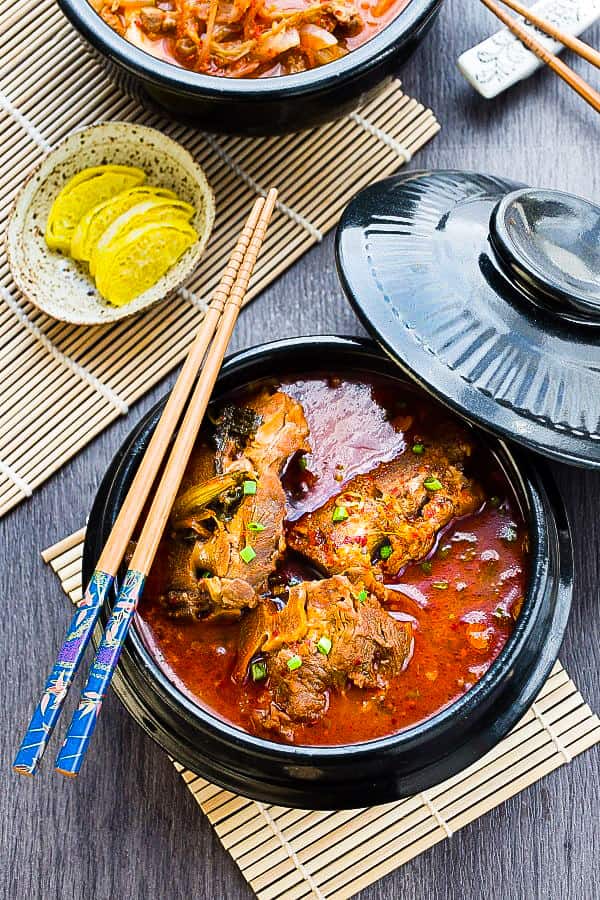
Discover the Irresistible Comfort of Pork Bone Soup
When it comes to soul-warming comfort food, few dishes can compete with the hearty and flavorful Pork Bone Soup, also known as “Gamjatang.” This Korean-inspired classic is a delicious medley of pork neck bones, vegetables, and a rich, savory broth that will leave you craving more.
Whether you’re a fan of Korean cuisine or simply in search of a satisfying, umami comforting meal to warm up on a chilly day, this recipe is sure to hit the spot. Enjoy the warmth and flavors of this delightful dish, perfect for any occasion!
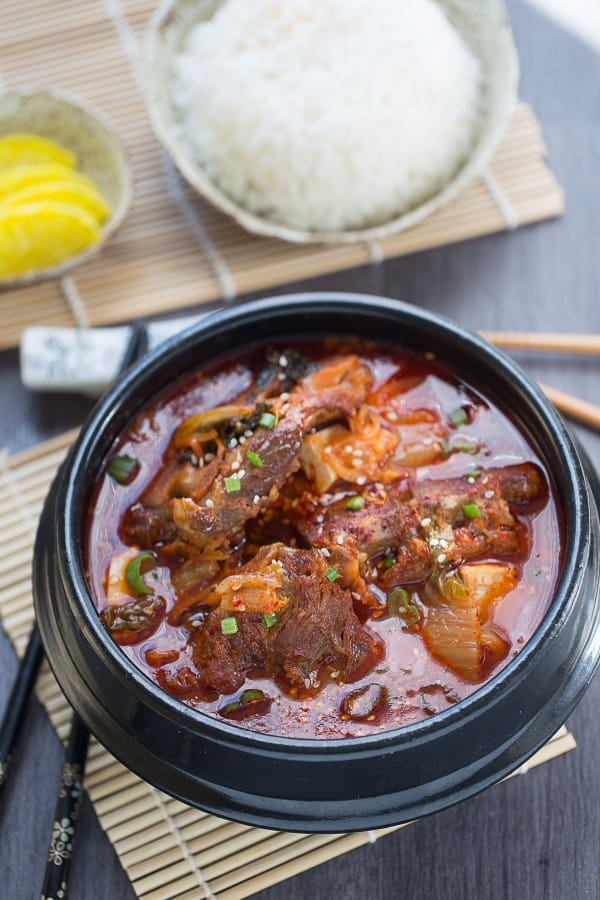
What is GamJaTang?
Gamjatang (감자탕) is a popular Korean soup known for its hearty and flavorful characteristics. It is often referred to as “Pork Bone Soup” in English, but the name “Gamjatang” translates to “potato stew” or “potato soup” in Korean. Despite its name, potatoes are just one of the many ingredients used in this dish.
The main components of Gamjatang include:
- Pork Bones: Typically, pork neck bones are used to create a rich and savory broth. These bones infuse the soup with a deep, meaty flavor.
- Vegetables: While potatoes are a prominent ingredient, Gam Ja Tang also includes other vegetables such as Napa cabbage, green onions, and Asian chives. These veggies add freshness and texture to the soup.
- Seasonings: Gamjatang is seasoned with a combination of ingredients like ginger, garlic, soybean paste (Doenjang), Korean red pepper paste (Gochujang), and Korean coarse red pepper powder (Gochugaru). These seasonings contribute to the complex and spicy flavor profile of the soup.
- Optional Ingredients: Depending on personal preferences, additional ingredients like shiitake mushrooms, perilla leaves, sesame seeds, and black pepper can be added to enhance the overall taste.
This Korean stew is known for its comforting and satisfying qualities, making it a beloved dish in Korean cuisine. It’s often enjoyed with a side of rice and various Korean banchan (side dishes) for a complete and wholesome meal. If you’ve never tried Korean Pork Bone Soup before, you are in for a real treat. You can order it at a local Korean restaurant first to see if you like it (it used to cost around $8.99 where we lived) or set aside a day (4-5 hours) to make this delicious dish.
Ingredients: Unveiling the Culinary Magic
Before we dive into the cooking process, let’s explore the essential ingredients that make Korean Pork Bone Soup a culinary masterpiece. You will need to purchase some of these ingredients at a Korean food mart or specialty Asian supermarket if you have one nearby.
- Pork Neck Bones: The star of the show, these bones infuse the broth with a rich, meaty flavor that’s irresistible.
- Water: The foundation of the soup, it helps extract all the delicious flavors from the ingredients.
- Onion: Adds a sweet and savory note to the broth, enhancing its depth.
- Dried Shiitake Mushrooms: These fungi provide a unique earthy aroma and umami flavor.
- Ginger: Slices of ginger are used initially to remove any porky smell, while minced ginger adds a fresh, zesty kick.
- Dried Red Chili Pepper: Infuses a subtle heat and complexity to the broth.
- Korean Soybean Paste (Doenjang): A staple in Korean cuisine, it brings a fermented, salty depth to the soup.
The Sauce: Elevating the Flavor
- Garlic: Adds a robust, aromatic punch.
- Fish Sauce: Infuses a delightful seafood umami.
- Cooking Wine: Enhances the overall depth of the soup.
- Korean Red Pepper Paste (Gochujang): Brings a sweet, spicy, and savory kick.
- Korean Coarse Red Pepper Powder (Gochugaru): Adds a smoky heat that elevates the broth.
Adding Vegetables and More
To complete the masterpiece, you’ll incorporate an array of vegetables and optional ingredients:
- White Potatoes: Their starchiness thickens the soup, making it heartier.
- Napa Cabbage: Blanching it keeps it crisp and vibrant.
- Green Onions: Add a fresh, mild onion flavor and a pop of color.
- Asian Chives: Provide a mild garlic-onion flavor.
- Optional Enhancements: Perilla leaves, sesame seeds, and black pepper offer extra layers of flavor and texture.
Instructions: How to make Pork Bone Soup (Gamjatang)
- Prepare the Pork Bones: Soak the pork bones in cold water for 2 hours to remove any blood. Afterward, wash and drain them thoroughly.
- Initial Boiling: Place the pork bones in a large stockpot and cover them with enough water. Add sliced ginger to help remove any porky smell. Bring it to a boil and skim off any scum that surfaces.
- Rinse and Reboil: Drain the water, remove the ginger slices, and rinse the pork bones. Then, add 10 cups of fresh water and bring it to a boil again.
- Add Flavorful Ingredients: Introduce sliced onion, dried shiitake mushrooms, minced ginger, dried red chili pepper, and Korean soybean paste (Doenjang) to the pot. Let it simmer for 1.5 hours over medium heat.
- Prepare the Flavorful Sauce: In a small bowl, combine minced garlic, fish sauce, cooking wine, Korean red pepper paste (Gochujang), and Korean coarse red pepper powder (Gochugaru).
- Enhance with Vegetables: Add the sauce, peeled and quartered white potatoes, blanched Napa cabbage, diced green onions, diced Asian chives, and optional ingredients like Perilla leaves and roasted sesame seeds to the soup. Simmer for another 30 minutes.
- Serve with Flair: Transfer the soup into a serving bowl or Korean earthenware, and garnish with sesame seeds and black pepper. Serve hot with rice and Korean banchan (side dishes).
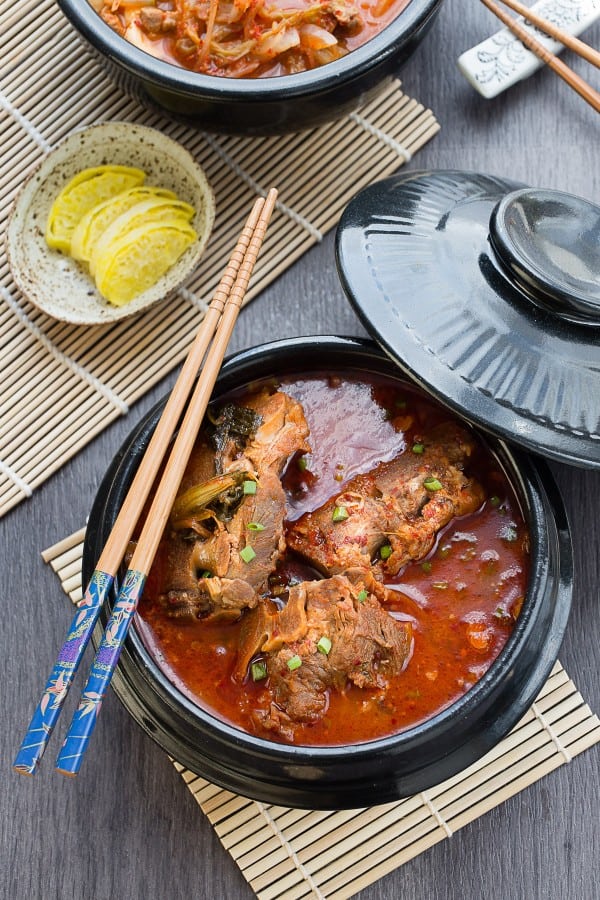
Tips for Success
- Soak and Rinse: Soak the pork bones to remove any blood and rinse them thoroughly to ensure a clean, flavorful broth.
- Skim the Scum: During the initial boiling, be sure to skim off any scum that rises to the surface for a clearer broth.
- Time and Patience Matter: This soup does require some patience and tolerance and is a medium level of difficulty to cook but your efforts will be well worth the reward waiting for you. Let the soup simmer for the recommended time to develop its rich flavors. The pork bones require 2 hours of soaking in water and around 2 hours for simmering.
Storage and Freezer Instructions
To store: Pork Bone Soup reheats beautifully, making it an excellent choice for meal prep. Store it in an airtight container in the refrigerator for up to 3-4 days.
How to freeze: Alternatively, make a big batch and freeze in resealable containers or freezer bags for up to 2-3 months for a quick and satisfying meal in the future.
Serving Suggestions
Serve your Pork Bone Soup with potatoes piping hot in a bowl or traditional Korean earthenware. Top it with sesame seeds and a dash of black pepper for that final touch of perfection. Pair it with rice and Korean banchan (side dishes) for a truly authentic experience.
Variations and Substitutions
Feel free to get creative with your Pork Bone Soup:
- Protein Choices: Substitute pork neck bones with other meats like pork ribs or chicken for a different twist.
- Veggie Delight: Experiment with various vegetables or mushrooms to suit your taste.
- Spice It Up: Adjust the heat level by altering the amount of Korean red pepper paste and powder.
- Vegetarian Option: Create a vegetarian version by omitting the meat, adding tofu and using vegetable broth.
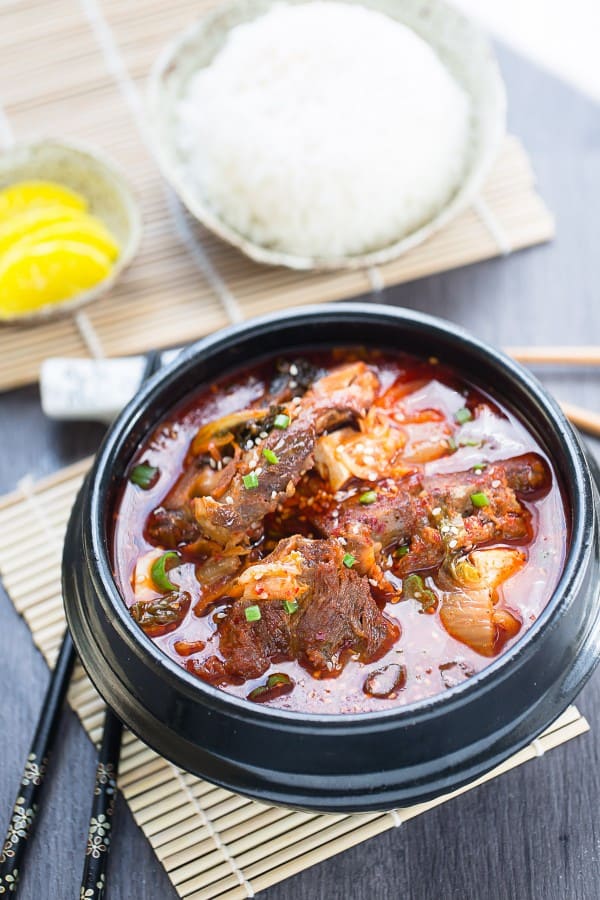
FAQ (Frequently Asked Questions)
Q1: Can I use a different type of meat for this soup? A1: Yes, you can substitute pork neck bones with pork ribs or chicken for a different flavor profile.
Q2: What can I use as a vegetarian alternative to pork bones? A2: To make a vegetarian version, omit the meat and use vegetable broth instead.
Q3: Where can I find Korean ingredients like Gochujang and Gochugaru? A3: These ingredients are typically available at Korean or Asian supermarkets. You can also find them online if you don’t have a local store nearby.
Q4: How should I store leftovers? A4: Store leftovers in an airtight container in the refrigerator for up to 3-4 days. For longer storage, freeze the soup for up to 2-3 months.
Q5: Can I adjust the spiciness level of the soup? A5: Yes, you can control the heat by varying the amount of Korean red pepper paste and powder you add. Start with less if you prefer a milder flavor and increase to your taste.
Q6: Are there any other optional ingredients I can add for extra flavor? A6: Besides the suggested enhancements, you can get creative by experimenting with different vegetables or mushrooms to tailor the soup to your preferences.
More Korean-inspired recipes you will love:
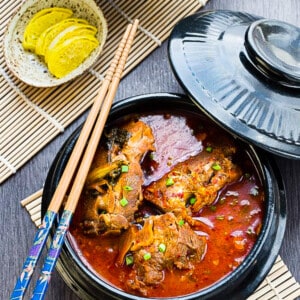
Experience the irresistible allure of Pork Bone Soup, a Korean classic stew brimming with rich pork neck bones, tender potatoes, fragrant ginger, and savory soybean chili paste. Dive into a world of authentic Korean flavors with this hearty and comforting recipe perfect for warming up on a cold day.
- 6-8 pieces pork neck bones about 1.4 kg
- 10 cups water
- 1 large onion sliced
- 2 dried shiitake mushrooms
- 4-5 slices ginger to remove pork smell
- 1 tablespoon minced ginger
- 1 dried red chili pepper remove seeds
- 2 tablespoons Korean soybean paste Doenjang (found in Korean or Asian supermarkets)
- 6-8 cloves garlic minced
- 3 tablespoons fish sauce
- 3 tablespoons cooking wine
- 1 tablespoons Korean red pepper paste Gochujang (found in Korean or Asian supermarkets)
- 2 tablespoons Korean coarse red pepper powder Gochugaru (found in Korean or Asian supermarkets)
- 4 large white potatoes peeled, quartered
- 1/4-1/2 napa cabbage sliced in quarters blanched
- 2 stalks of green onions diced
- 1/2 cup Asian chives diced
- 10 Perilla leaves, sliced in thick strips (found in Korean or Asian supermarkets)
- Roasted sesame seeds
- Black pepper
- Soak the pork bones in a large bowl in cold water for 2 hours to remove any blood. Drain water and wash bones.
- Put the bones into a large stock pot and fill with enough water to cover the bones. Add 4-5 slices of sliced ginger (to remove the pork smell). Boil water and remove any scum that surfaces to top of water.
- Drain water, discard ginger slices and rinse the pork bones.
- Add 10 cups of new water to pork bones and boil again.
Add sliced onion, dried shitake mushrooms, minced ginger, soy bean paste and dried red chili pepper to pot. Boil the pot for 1-1/2 hours over medium heat.
About 1-1/2 hours later, take the red hot chili pepper and shiitake mushrooms out of the pot.
- Slice shiitake mushrooms into bite sized pieces.
- In a small bowl, combine the minced garlic, fish sauce, cooking wine, Korean red pepper paste and Korean coarse red pepper powder in a bowl.
- Add the sauce, potatoes, Napa cabbage, green onions, asian chives, soy bean sprouts, Perilla leaves and the chopped shiitake mushrooms into the soup. Simmer on medium heat for another 30 minutes.
- minutes later, transfer the soup into a serving bowl or Korean earthenware, top with sesame seeds and/or black pepper.
- Serve with rice and/or Korean banchan (Korean side dishes).
This soup takes time and patience and requires some ingredients from a Korean or Asian supermarket but the flavorful broth combined with the fall of the bone pork will be well worth the effort. The total time from start to finish to complete will take around 4-5 hours.

 Did you try this recipe?
Did you try this recipe?






Meg -
Thanks for sharing this recipe, it sounds delicious. Do you mind sharing how to save and freeze the broth and use for another time? This is my husband’s favorite soup and i’D love to make this easier To get multiple dinners over time.
Krista -
This was incredible. Our family loved it. Thank you
Kelly -
Thanks so much and for pinning Krista 🙂 We just tried Korean food a few years ago too and have been hooked ever since since we love the earthy spicy flavors. Happy New Year and hope you have a great weekend sweetie 🙂
Elle -
Yum, I’m going to try it today and wanted to know how spicy this soup is? Can I make it mild so that my 3 year old cn drink IT too?
Thanks!
Kelly -
Hi Elle, this soup does have a spicy kick to it. My son is 3 as well and this is a little bit spicy for him. You may have to leave out the the dried red chili pepper as well as the Korean red pepper powder (Gochugaru) in the recipe. Hope you enjoy the soup as much as we do 🙂
Laura / Savory Snacks and Treats -
I tried making this gamjatang yesterday and it was to die for! Tastes just like if not better than the local Korean restaurant we frequent. Thanks for the superb recipe and step by step photos and instructions. Much appreciated:)
Kelly -
Thanks so much for coming back and letting me know Laura. I am so happy that you had great results with the Gamjatang:)
Emily -
Holy yum, this was delicious! We love Gamjatang in our house.
Kelly -
Thanks Emily. You should definitely give this recipe a go if you are able to set aside the required amount of time – the results will be amazing and you WILL look like a hero 🙂
marvin -
No Asian markets near me do you need to use perilla leaves
Kelly -
Hi Marvin, no, it’s not necessary but the perilla leaves certainly give the pork bone soup that authentic distinct aroma and flavor. It still tastes wonderful without it though 🙂 Hope that helps and thanks for stopping by 🙂